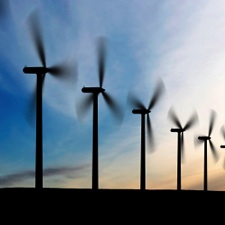
Can Flywheels Help Balance Electricity Supply and Demand?
Beacon Power hopes to demonstrate the feasibility of the old technology to help balance fluctuating inputs from renewables
Nov 19, 2009 - Michael Burnham - Scientific American
 |
ROUND AND ROUND: Electricity from renewable sources, like wind turbines, could be stored in new flywheel facilities.
ISTOCK/SHARPLYDONE |
Beacon Power Corp. broke ground today on a 20-megawatt, energy-storage facility in southeastern New York.
The Rensselaer County project, slated for completion in 2011, would be the first in the nation to use a "flywheel" frequency regulation system to balance electricity supply and demand, according to the Tyngsboro, Mass.-based company. The $69 million facility would store electricity as kinetic energy in a matrix of massive discs when grid supply outstrips demand.
The ability to move power in and out of the system and maintain proper electricity frequency -- about 60 cycles per second -- will make the nation's electricity grid "smarter," Beacon President and CEO Bill Capp contended in a written statement.
"Our flywheel systems provide an essential grid-stabilizing service, and they do it faster and much more efficiently than today's conventional methods, most of which consume fossil fuel and produce harmful [carbon dioxide] greenhouse gas emissions," he added.
In July, the Department of Energy conditionally approved a $43 million federal loan for Beacon's project. DOE has not issued final approval of the loan guarantee but aims to do soon, a department spokeswoman said today.
In August, Beacon applied for two grants, totaling up to $46.7 million, under DOE's Smart Grid Demonstration program. If approved, each grant would fund up to 50 percent of the cost of Beacon's second and third 20-megawatt plants, the company noted in a filing with the U.S. Securities and Exchange Commission. Company officials did not return phone calls or e-mails seeking comment for this article.
A recent report by GTM Research projects that "power oriented" energy storage -- used mainly to regulate short-term changes to grid frequency -- will grow quickly in the near term but will be constrained in the long term by a limited market. Conversely, "energy oriented" storage -- in which energy use is shifted to other times of the day -- has a massive total market size and is only beginning to emerge.
Reprinted from Greenwire with permission from Environment & Energy Publishing, LLC. www.eenews.net, 202-628-6500

|
